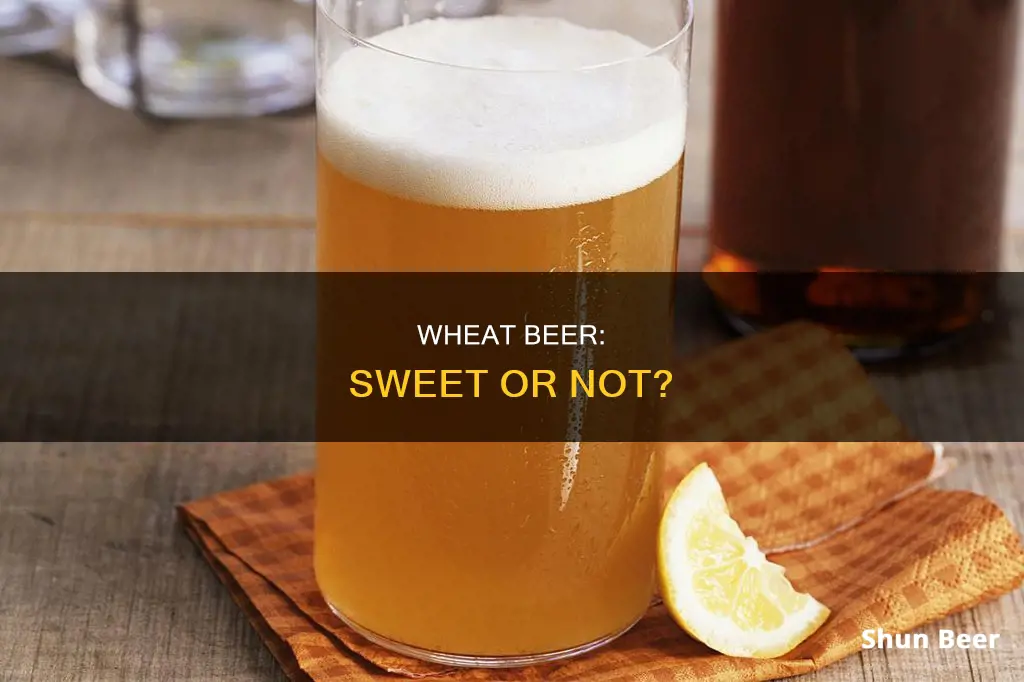
Wheat beer is a top-fermented beer with a large proportion of wheat relative to the amount of malted barley. Wheat beers are usually light in colour and low in bitterness, with a fruity flavour and a creamier mouthfeel. The most popular imported style is German Hefeweizen, which has a sweet, bready flavour and bright, citrusy orange notes. The sweetness of wheat beer comes from its relatively high malt content.
What You'll Learn

Wheat beer is usually light in colour and low on bitterness
Wheat beer is a top-fermented beer that is brewed with a large proportion of wheat relative to the amount of malted barley. The two main varieties are German Weizenbier and Belgian witbier. Wheat beers are typically light in colour, ranging from pale straw to golden, and are often cloudy or hazy in appearance due to the presence of yeast and wheat proteins. They are usually low to medium in alcohol content, ranging from 2.5% to 5.6% ABV.
The Hefeweizen style, a German wheat beer, is particularly known for its low hop bitterness, with about 15 IBUs, and relatively high carbonation. This style is important in balancing the beer's relatively malty sweetness. Hefeweizen also has a unique phenolic character, with a signature phenol called 4-vinyl guaiacol, which gives it a clove-like and slightly medicinal or smoky flavour. Other flavour notes produced by the Hefeweizen yeast include banana, bubble gum, and sometimes vanilla.
The Belgian witbier, or "white beer", is also a wheat beer variety that uses raw unmalted wheat and flavourings such as coriander and orange peel. It gets its name from the suspended yeast and wheat proteins that give the beer a hazy, white appearance when cold. This style of wheat beer is dry, bubbly, and lightly spicy.
American wheat beer, on the other hand, tends to be slightly hoppier than German-style wheat beers. It is made with lager or ale yeast and has a light and drinkable profile.
Overall, wheat beers are known for their light colour, low bitterness, and refreshing qualities, making them easy to drink and pair with a variety of dishes.
Belgian White Wheat Beer: Healthy Choice or Not?
You may want to see also

German Weizenbier and Belgian Witbier are the two main varieties
Wheat beer is a top-fermented beer brewed with a large proportion of wheat relative to the amount of malted barley. The two main varieties are German Weizenbier and Belgian Witbier, with other types including Lambic (made with wild yeast), Berliner Weisse (a cloudy, sour beer), and Gose (a sour, salty beer).
German Weizenbier
Weizenbier, also known as Hefeweizen, is a beer traditionally from Bavaria, where it was introduced in the 15th century. In Weizenbier, a significant proportion of malted barley is replaced with malted wheat. By law, Weizenbiers brewed in Germany must use a "top-fermenting" yeast. These specialised strains of yeast produce overtones of banana and clove as by-products of fermentation. The Hefeweizen style is particularly noted for its low hop bitterness and relatively high carbonation, which balances the beer's relatively malty sweetness. Weizenbier is available in a number of other forms, including Dunkelweizen (dark wheat) and Weizenstarkbier (strong wheat beer), commonly referred to as Weizenbock. The dark wheat varieties are made with darker, more highly kilned malts (both wheat and barley).
Belgian Witbier
Witbier, or "white beer", is a barley/wheat, top-fermented beer brewed mainly in Belgium and the Netherlands. It gets its name from the suspended yeast and wheat proteins, which cause the beer to look hazy, or white, when cold. Witbiers traditionally use unmalted wheat, whereas Weizenbier uses wheat malt. Witbier contains less wheat than Weizenbier, which influences the overall taste profile. Witbiers are brewed with additions such as coriander seeds and curaçao peels, which are the peels of a bitter orange. The soft, sweet, fruity character of Weizenbier, on the other hand, comes solely from the yeast.
Is Pacifico Beer Wheat-Based?
You may want to see also

Wheat beer is a top-fermented beer
Wheat beer, as the name suggests, is brewed with a large proportion of wheat relative to the amount of malted barley. The exact percentage of wheat varies, with Bavarian wheat beers using 50% wheat and American wheat beers using 20-30%. The higher the percentage of wheat, the slower the lautering process will be. Wheat beers also tend to have a finer mill setting than barley-based beers.
The two main varieties of wheat beer are German Weizenbier and Belgian Witbier. German Weizenbier, also known as Hefeweizen or Weißbier, is traditionally from Bavaria and is known for its pale straw to golden colour and hazy appearance. It typically contains little to no hoppy bitterness and instead emphasises the malt profile, resulting in a malty sweetness. Belgian Witbier, on the other hand, is often made with raw unmalted wheat and is spiced with coriander and orange peel, giving it a unique flavour profile.
In addition to the main varieties, there are several other styles of wheat beer, including Berliner Weisse, Gose, and Lambic. Berliner Weisse is a cloudy, sour beer that originated in Germany and has a low alcohol content, typically ranging from 2.5% to 4% ABV. Gose is a wheat beer with a salty flavour, and Lambic is made with wild yeast and is often spontaneously fermented.
Wheat beers are known for their rich body and smooth, full-bodied flavour. The wheat gives the beer a distinct bready taste and contributes to a more stable foam and a hazy appearance. The best wheat beers strike a balance between richness and drinkability, making them a popular choice for craft breweries and beer enthusiasts alike.
The Wheat Beer Experience: Flavor, Aroma, and Taste
You may want to see also

German Weizenbier is also known as Hefeweizen
Wheat beers are top-fermented beers brewed with a large proportion of wheat relative to the amount of malted barley. The two main varieties are German Weizenbier and Belgian witbier. German Weizenbier, or Hefeweizen, is a wheat beer that traditionally comes from the Southern German region of Bavaria. The name Hefeweizen comes from the German words "hefe", meaning yeast, and "weizen", meaning wheat. Hefeweizen is therefore an unfiltered wheat beer with yeast in it, which gives the beer its cloudy appearance.
The Hefeweizen style is particularly noted for its low hop bitterness and relatively high carbonation. This balances the beer's relatively malty sweetness. Hefeweizen's phenolic character has been described as "clove" and "medicinal", but also smoky. Other more typical but less assertive flavour notes produced by the Weizenbier yeast include "banana", "bubble gum", and sometimes "vanilla". The aroma and flavour of a Weizenbier come largely from the yeast and are decidedly fruity (banana) and phenolic (clove). The intensity of these wildly differing flavour qualities varies depending on the brewer, but the two are most commonly balanced.
German Weizenbier is best served in a "Weizen vase", a large curvaceous glass that showcases the beer's beautiful glow and corrals its large, persistent foam cap given the style's characteristic effervescence. A German Weizenbier must showcase the Weizen yeast's one-two punch of fruit and spice to be recognised as a German Hefeweizen. The bright fruitiness of banana alongside the pungency of clove allow this beer to work well with a variety of lighter foods, such as salads, seafood, and even a variety of egg dishes.
The Pilsner and Wheat Beer Divide: What Sets Them Apart?
You may want to see also

Witbier is made with unmalted wheat and flavoured with coriander and orange peel
Wheat beers, especially those originating in Europe, are some of the oldest styles of ale produced today. Wheat beers can vary in flavour profile from light and refreshing to dark and silky, but most are light to medium-bodied and have a hazy appearance.
Belgian witbiers, or "white beers", are traditionally brewed with a hefty amount of wheat malt, barley malt, and oats. They are also flavoured with coriander and orange peel, and sometimes chamomile. The use of unmalted wheat and rare or secret spices led to their mystique. The high wheat content gives witbiers a bready flavour, but often with a lightly honey-sweet quality. The coriander and orange peel are added during the last few minutes of the boil to preserve their aromatic qualities. Witbiers are moderately alcoholic, usually in the 4.5 to 5.5% ABV range.
Wheat Beers: Healthy Choice or Just Hype?
You may want to see also







